| Published
on 27
Sep
2021 |
All rights reserved.
|
|
|
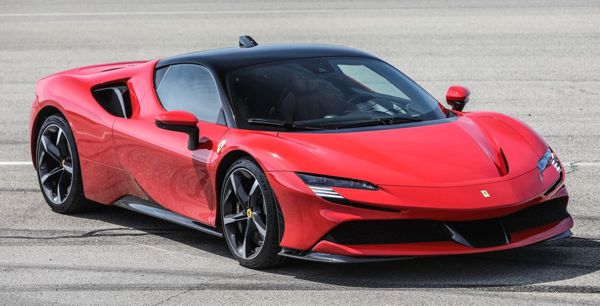
|
|
A
hypercar? A production car? The SF90 is both !
|
|
The SF90 achieves many
firsts. It is the first plug-in hybrid Ferrari, whereas LaFerrari is
only a hybrid with a small battery. It is the first Ferrari capable of
zero emission driving, through which it becomes the first front-wheel
drive Ferrari, too. To purists, these “firsts” are not something to
applaud, but we know it is a must under increasing regulation pressure.
At least, Ferrari has yet to throw in the towel and commit to abandon
petrol engines, unlike Bentley and Lotus. The SF90 is an experiment, a
test bed to the plug-in hybrid technology that may carry Maranello
through the next 10 or 15 years. Whether combustion engines will be
banned globally beyond that point remains to be observed, as Italy is
persuading EU to relax the rules for low volume car makers. But Ferrari
has to prepare for big changes, and the SF90 is an answer.
As it is an experiment, it is not supposed to replace any existing
Ferraris. This is the first time Maranello running the 5th product line
– beside the V8 front-engined GT (Portofino and Roma), V8 mid-engined
supercar (F8 Tributo), front-engined 4-seater (late GTC4, soon
“Purosangue”) and V12 front-engined super sports car (812 Superfast). I
don’t count LaFerrari as a product line because it is not a production
model. It should be seen as a special project that occupies a
production line only a couple of years in a decade, with production
limited to 500 cars and a price falling into Million Club. Unlike it,
the SF90 Stradale is a
production model, like a Lamborghini Aventador, just faster and more
expensive. With a price starting from £376,000 and easily
exceeding half a million pounds after options, it is twice as expensive
as the F8 Tributo and 50 percent more than 812 Superfast, so it
occupies the top spot of Maranello’s production model tree. 25 years
after the
retirement of F512M, the flagship Ferrari finally returns to mid-engine
camp.
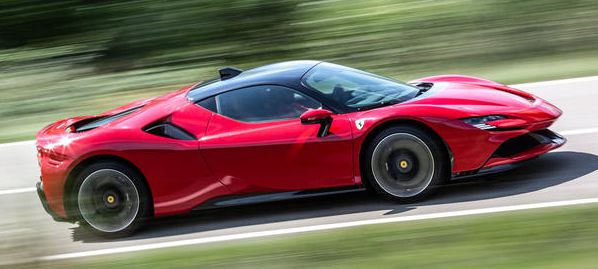
|
|
25
years after the retirement of F512M, the flagship Ferrari finally
returns to mid-engine camp.
|
|
If you have seen the SF90 Stradale in person, you will find it very
exotic. Extremely low, wide and sharp, has a pointy nose and a flowing
waistline like 458. The proportion might be a bit too long – it needs
to accommodate battery – but this extra size does give it the presence
of a flagship model, just like the days of Testarossa. Interestingly,
the front-end design looks like Pininfarina Battista, although the
Italian design house is no longer responsible for Ferrari. The rear end
styling is a bit busy and overdone for my taste though.
The aerodynamics development concentrates on improving cooling and
downforce. There are 3 radiators at the nose. The center one cools the
electric motors and inverters, while those at either side cool the
engine and gearbox. The side intakes behind the doors are used to cool
the turbocharger's intercoolers. At the bottom of the car, Ferrari
added
vortex generators under the front axle to balance the downforce
generated by the rear diffusers. At the back, a new patented
aerodynamic
aid called "shut-off Gurney" adds a movable section to the rear
spoiler, which can be lowered to increase downforce. As this is
primarily a street car, the Stradale skips big rear wing and side
winglets etc. However, with optional “Assetto Fiorano”
pack installed, its rear spoiler extends a little bit higher, resulting
in 390 kg of downforce at 155 mph, better than many track-oriented
sports cars.
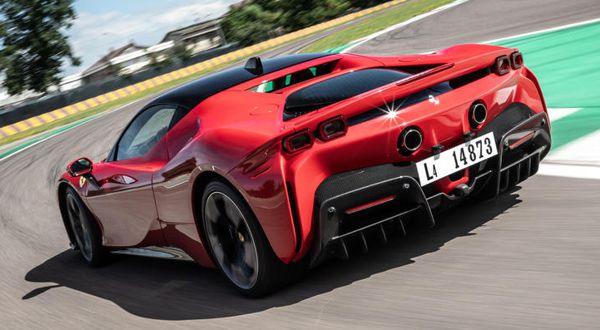 |
|
Though
lack of big wings, it generates 390kg of downforce at 155 mph, better
than many track-oriented sports cars.
|
|
Ferrari is not the first to build a plug-in hybrid supercar, of course.
Porsche was the first there by introducing 918 Spyder in 2013. The SF90
has a mechanical layout very close to Porsche: a 7.9kWh lithium
battery, weighing 72kg, is placed behind the cockpit and fore of the
engine compartment. A disc-shape motor is sandwiched between the V8
engine and 8-speed DCT gearbox. The front wheels are driven by motors
as well. However, where the Porsche employs one motor to drive the
front wheels via differential, the SF90 uses 2 motors, one for each
wheel, so that it achieves torque vectoring easily. It’s not a new
invention, as Honda NSX has been using this arrangement since 2016,
although that car is not a plug-in hybrid. As the front motors have no
gearbox, they are geared to work below 130 mph. Above that, they are
disengaged by clutches, so the car reverts to purely rear-drive at
higher speeds.
Ferrari does not provide specifications of these 3 motors, but they are
powerful enough to make use of the 220 hp output of the battery. This
means, above 130 mph, all electric power will be directed to the rear
motor. When driven in electric mode, the SF90 is a 220hp front-wheel
drive hot hatch, though it has a range of only 25 km (15 miles). It can
be charged at home, but I suppose few would do so for a range barely
enough to go to the nearest pub to have a drink. Most would let the
engine recharge the battery on the run. However, the plug-in capability
does allow WLTP emission drop to 154 g/km, lower than a typical hot
hatch.

|
|
Technology-wise,
it breaks no new ground from 918 Spyder or NSX.
|
|
The twin-turbo V8 is developed from the F154 unit of 488 and F8. Its
bore is increased from 86.5 to 88mm, while stroke is reduced by 1mm to
82mm, increasing the capacity slightly to 3990 c.c. It gets
freer-breathing intake and exhaust manifolds as well as lighter
Inconel exhausts. The cylinder heads are new, with fuel injectors moved
to the center and ignition moved to the side, along with shorter intake
ducts for high tumble rate. Injection pressure has been increased to
350 bar. The turbos get reshaped volute for higher efficiency and are
mounted lower. Output is therefore lifted from 720 to 780 horsepower at
7500 rpm, while torque improves from 568 to 590 lbft at 6000 rpm,
Redline remains unchanged at 8000 rpm.
When the V8 and electric motors work together, the SF90 delivers an
astonishing 1000 horsepower, even more than LaFerrari. Even though the
car is quite heavy, performance is startling: 211 mph top speed, 0-60
mph in 2.45 seconds and 0-124 mph in 6.7 seconds – the latter puts it
just ahead of LaFerrari, McLaren P1 and Senna, if not Bugatti,
Koenigsegg or some upcoming electric hypercars. It is not the final
word of performance, but considering it is a production model and costs
way less than a million dollar, such performance is
deeply impressive.
In Maranello's Fiorano circuit, the SF90 is good for 1:19.0 a lap, 0.7
second less than LaFerrari and 2.5 seconds quicker than 488 Pista. Opt
for the Assetto Fiorano pack (more on that later), it can shave another
0.3 second.

|
|
The
blend of electric and petrol power is so seamless that you won’t notice
the intervention of electric power. You just find the SF90 gather speed
in incredible pace, far beyond the level of F8.
|
|
What separate a production model from a million-dollar hypercar is
usually the use of exotic materials and construction. The SF90 has to
be built on conventional assembly line using cost-effective production
technique, therefore its chassis construction is similar to that of F8.
The main structure is made of aluminum spaceframe, although it gets a
carbon-fiber rear bulkhead for reinforcement, a technique first used by
Lamborghini Huracan. Some aluminum ribbed castings are replaced with
lighter hollow castings, but an aluminum spaceframe is still no
carbon-fiber tub. Likewise, lighter 7000-series aluminum alloy is no
replacement for carbon-fiber in body paneling. The chassis of SF90 is
40 percent stiffer in torsion than that of the F8, but it is no
lighter. In addition of the 270 kg of motors, battery and power
electronics, no wonder it tips the scale at 1570 kg, some 315 kg more
than LaFerrari, 240 kg more than F8 !
And that is the dry weight with all lightweight options ticked,
including carbon-fiber wheels and bucket seats as well as the
aforementioned Assetto Fiorano pack. The latter includes carbon-fiber
door panels, underbody and rear spoiler, titanium suspension springs
and exhaust, Michelin Cup 2 tires and replacing magnetorheological
adaptive dampers with passive Multimatic DSSV
dampers, which loses “bumpy” mode in the process.
Fortunately, the SF90 has its considerable mass distributed sensibly,
45:55 front to rear and very low in the chassis. This is helped by a
new Getrag 8-speed twin-clutch transaxle that is 10kg lighter (3kg of
which comes from the deletion of reverse gear, as the front motors do
the job), and a smaller diameter clutch that allows the entire
powertrain to be mounted 15mm lower. New hydraulic actuators allow the
gearbox to shift smoother yet faster: it takes only 200ms, compared
with 300ms on the 488 Pista.
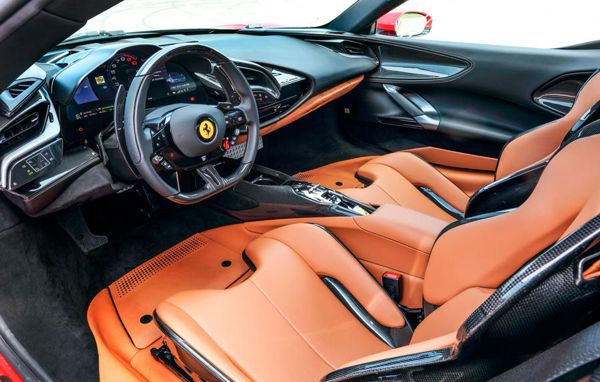
|
|
Brake-by-wire
blends regenerative braking and mechanical braking seamlessly.
|
|
Have I forgotten anything? Yes, the name. SF90 denotes Scuderia Ferrari
90 years, as Enzo Ferrari founded his racing team in 1929 (although at
that time he ran Alfa Romeo cars), while Stradale means street car. As
it is stradale, its cabin keeps the usual leather and comfort features
of Ferrari road cars. Its digital instrument panel is a huge, 16-inch
HD screen, which doubles as infotainment screen, allowing the driver to
concentrate on the straight ahead. The spokes of the steering
wheel are added with touch pads for navigating the screen, though
prone to be touched accidentally. There is also a head-up display. Your
feet are raised 15mm compared with in F8 owing to the vortex generators
underneath. Otherwise, the cabin and driving position are just as
intuitive as in other mid-engined Ferraris. Space is more generous than
most hypercars with carbon tub. Seats are superb. Visibility is great
except rearward.
Not so great is luggage space. There is precious little space behind
the seats, and
the front boot falls victim of the electric drivetrain, offering only
74
liters (F8 offers 200 liters). A cross-country trip with a weekend’s
luggage? No way. To country club play golf? No way. This is probably
the biggest weakness of Stradale, especially considering its name.
However, the performance it offers is truly awesome. Forget the
electric mode, which is installed mainly to avoid awakening your
neighbors in early morning and deceiving emission laws. If you love
silent commuting, you won’t buy a Ferrari. You buy it because you love
the noise and emotional character of Ferrari motors. Even though the
SF90 is not quite as furious and sonorous as the 812 Superfast, it is
still a Ferrari motor. The sound has more bass than the F8. The angry
howl remains. Throttle response is made even sharper by the electric
motors, while turbo lag low down is lighter than any turbocharged
supercars. Keep the engine boiling at over 3000 rpm and you may be hard
pressed to tell if it is turbocharged.
The blend of electric and petrol power is so seamless that you won’t
notice the intervention of electric power. You just find the SF90
gather speed in incredible pace, far beyond the level of F8. Each
upshift of the DCT is taken at lightning speed, and soon you are
running out of road space. The car is so quick that it makes a long
straight feel short, the experience is breathtaking, and you are aware
that its performance is far more than you can access on a public road.
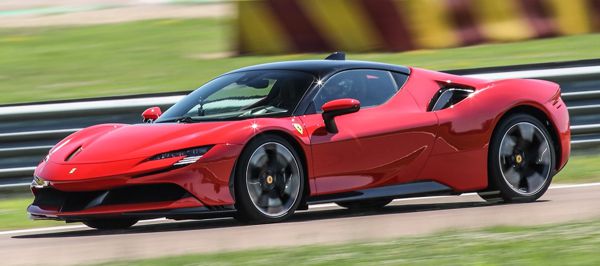
|
|
It
is easier to handle at the limit than LaFerrari. In fact, easier than
any hypercars.
|
|
On a track, the SF90 displays all the cornering quality of a 488 Pista
despite its extra mass it carries. Its steering is quick and precise.
Its
cornering limit might not be as high as a Senna, blame to its
considerable weight and less downforce, nor it would brake as hard, but
it shows a surprisingly docile handling. The front wheels’ torque
vectoring working in tandem with Side Slip Control to deliver
remarkable traction and cornering stability, keeping the nose pointing
precisely to the desired path. Sport mode allows some
room for oversteer if you go for it. Race mode allows more spectacular
power slide
without risking control. It is easier to handle at the limit than
LaFerrari. In fact, easier than any hypercars with as much power and
performance. Only CT-Off (traction control off) or ESC-off (stability
control off) uncover its raw physics and the beast side of 1000
horsepower, by then it could be a handful to master. No one else makes
electronic driving aids as competent yet invisible as Ferrari, so there
is really no reason to go beyond Race mode.
Even the brakes are surprisingly good. It is always not easy to blend
regenerative braking with mechanical braking. Porsche 918 Spyder did
not quite manage that. LaFerrari and McLaren P1 simply skipped
regenerative braking for good reasons. But Honda NSX made that,
thanks to using brake-by-wire system with pedal pressure simulator. The
SF90 is the same. Its short-travel pedal feels responsive and natural,
and it compensates for fade after extended use, so the braking response
and pedal feel remain consistent.
Only soft braking at urban speeds would result in a slightly abrupt
response.
On mountain roads, the SF90 rides out bumps and undulations remarkably
well, even on passive DSSV dampers. At hairpins, you will feel the
torque fed to the front wheels through the steering, which is a bit
strange for a Ferrari. Otherwise, the handling feels as good as you can
hope for – precise, reassuring and forgiving. The steering, while still
taking only 2 turns from lock to lock, feels calmer just off center
than the helm of F8 or 812, a welcomed improvement.
The only question is whether you need all that extra performance over
an F8 or Pista. A
1000hp hypercar is always a philosophical question. No one can ever use
all that power on road, or even track. While both engine and electric
motors working together at maximum thrust, the SF90 feels so fast that
it could be scary. Human drivers are simply not responsive enough to
keep up with its speed. In the end, you tend to relax a bit, shift to
higher gears and avoid accessing its deep reserves. Maybe Gordon Murray
is right. What’s the point to build a 1000hp hypercar if you have no
chance to enjoy it? Why not stick with a small-capacity naturally
aspirated V12, stick shift and rear-drive so that you can cut 700kg,
enjoy pushing the car on roads and listening to its wonder noise? The
SF90
is a great car, no question. A great achievement for transforming a
complicated piece of machinery and electronics into a seamless driving
experience. However, it is also a great pain to know you are only
scratching its surface.
|
Verdict:      |
| Published
on 4
Dec
2023 |
All rights reserved.
|
|
SF90 XX
|
|
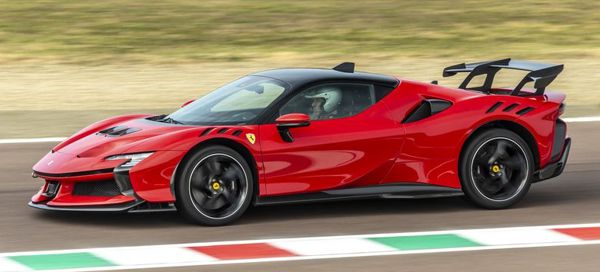
|
|
The
first road-legal XX is effectively an updated SF90.
|
|
Ferrari's XX series started
life from the Enzo-based FXX and FXX Evo, then 599XX and FXX K
(LaFerrari-based). All of them were purely track cars. They were very
expensive toys for very rich gentleman drivers to play on dedicated
track days, otherwise stored and maintained by Maranello. It goes
without saying all were built in limited numbers and sold at million
dollars apiece.
The new SF90 XX is different. It is road-legal like the standard SF90.
It is not very rare either, as 799 Stradales and 499 Spiders are slated
to be built. Pricing is relatively “reasonable” at £674,000 and
£744,000, respectively. Yes, not in terms of million, isn’t it a
bargain for a range-topping special edition Ferrari?
That depends on how you see it. The SF90 XX is faster than the standard
car, of course, but not as quick as it appears to be. It needs 2.25
seconds and 6.5 seconds to go from zero to 60 and 124 mph,
respectively, cutting merely 2/10ths of a second in both cases. Despite
the big rear wing, it laps Ferrari’s Fiorano track just 0.8 sec less
than the standard car. And then that rear wing and other
downforce-oriented modifications drop its top speed
from 211 to 199 mph, making it the first Ferrari top supercar since 288
GTO failing to break the 200 mph barrier.
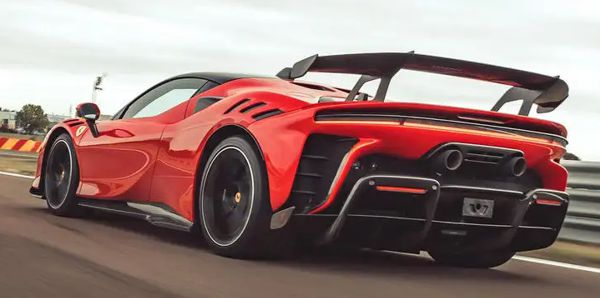
|
|
This
is the first time since F50 that a road-going Ferrari features a
standard rear wing.
|
|
The XX’s hybrid powertrain produces a combined 1030
horsepower, an
increase of only 30 hp over the SF90. 17 hp of which comes from the
twin-turbo V8, thanks to new pistons that raised compression ratio
slightly (9.54:1), polished intake and exhaust ports etc. 13 hp comes
from lifting battery output. More importantly perhaps, Ferrari has
improved the sound of the engine – a weakness of the SF90. They
reworked the sound tube connecting the engine compartment to the
cockpit for more noise. Besides, the 8-speed dual-clutch transaxle has
been recalibrated to be more aggressive. During each gearshift, the
engine lifts its combustion chamber pressure momentarily, delivering a
punchier shift and extra aural thrills simultaneously.
Disappointingly, weight reduction is
only 10 kg, achieved mainly by
using carbon-fiber bucket seats. With the complex 3-motor hybrid
system and 7.9 kWh battery, the SF90 XX is quoted a dry weight of 1560
kg,
so in running order it will be around 1700 kg, which is a lot for a
track car.
In fact, most effort has been spent to aerodynamics. Although Ferrari
is proud of its underbody aerodynamic know-how, the addition of a big
rear wing can add further downforce and by the way make the XX looking
so cool. The same goes for the very stylish louver vents opened on the
front and rear fenders, or the more pronounced front splitter and side
skirts. Finally, sacrificing the front luggage compartment, Ferrari
fits an S-duct into the nose, drawing cold air pass through the front
radiator and exit from the top of the bonnet. This not only adds
downforce but also improves cooling efficiency of the intercoolers,
because hot air from the front radiator is directed away from the path
of engine intakes. Overall, the XX produces 530 kg of downforce at 155
mph, an increase of 140 kg.
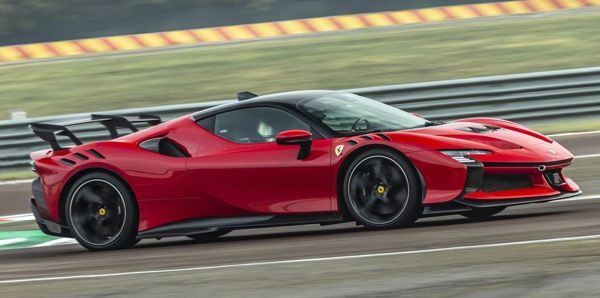
|
|
While
quicker than 296 GTB, the extra performance is not easy to extract...
|
|
Modifications to the chassis are more subtle. The suspension can be
still optioned with either magnetorheological adaptive dampers or
Multimatic DSSV dampers – the former more suitable to road use and the
latter more focused on track. Springs are stiffened by only 5 percent,
while larger rear brakes and new ABS Evo with 6W-CDS sensors are the
remaining improvements. Tire choices can be Michelin Cup 2 or Cup 2 R,
depending on applications.
On track, the SF90 XX is incredibly fast, predictably. The acceleration
is seamless yet brutal. The V8 revs crazily, while each upshift is
delivered with a punchy, very mechanical feel.
Like any modern Ferraris, its steering is very direct, but
communication through the helm is a bit in short supply. Fortunately,
there is sufficient body roll to tell you the state of cornering.
Turn-in is responsive, but the chassis is default to understeer. You
feel the pair of front motors working hard to pull the car out of
corner, but their works don’t always gel with you. If you over-react to
the understeer and feed more power in corner, the car can easily
oversteer. While 296 GTB or many mid-engined rear-drive Ferraris can
dance at the limit of adhesion beautifully, thanks to a progressive
manner and highly adjustable attitude, the SF90 XX falls victim to its
own weight and complexity. It requires you to follow its preferred
driving style: brake late, turn-in, let the ABS rotate the car, get
back on throttle at corner exit and wait for the motors to pull it out.
Manage that and it will be a very effective track tool, but also a
one-dimensional tool.
The SF90 XX is quicker than 296 GTB on a track, but it is not easy to
extract the extra performance. The smaller Ferrari is simpler, more
transparent in its behaviour and therefore more engaging and more fun
to drive. From this perspective, the XX seems unreasonably expensive.
|
Verdict:     |
|